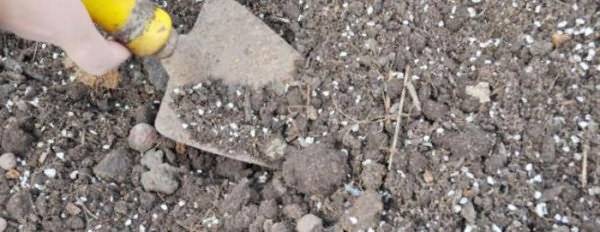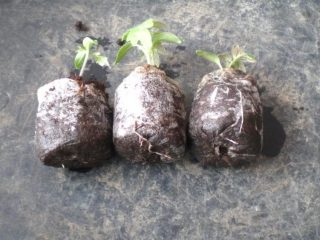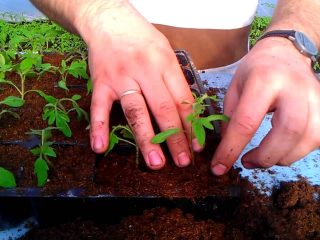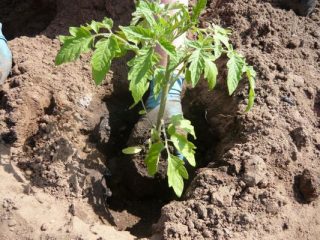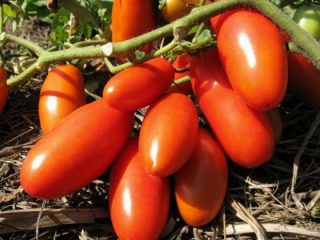Content
All gardeners who grow tomatoes on their plots are wondering what fertilizer to choose for these vegetables. Many have opted for a complex mineral fertilizer - nitrophosk or nitroammophoska. These are identical substances that increase the quality and fertility of the soil. As a result, tomato yields can be significantly increased. This article contains information about using nitrophoska as a fertilizer for tomatoes.
Composition of nitrophoska
This fertilizer is a mixture of minerals necessary for the growth and development of various crops. The main components of nitrophoska are potassium, nitrogen and phosphorus. Without these minerals, no cultivated plants would simply be able to grow. The fertilizer is sold in granular form. It easily dissolves in water and is easily washed out of the soil. This means that the period of action of fertilizer on sprouts is very short.
Despite the size of the granules, they contain a whole complex of minerals. The composition of nitrophoska includes the following substances:
- ammonium and potassium nitrate;
- potassium chloride;
- ammonium phosphate;
- surerphosphate;
- phosphorus precipitate.
These are the main components, to which other minerals can be added for a specific vegetable crop or soil type. For example, almost all manufacturers of nitrophoska add magnesium or copper, sulfur, zinc, and boron to the fertilizer. You can determine the quantity of each element by the numerical designations on the packaging.
Disadvantages and advantages
Like all mineral supplements, nitrophoska has some pros and cons. The positive properties of this fertilizer include the following properties:
- Basic minerals make up at least 30% of all components. Thanks to this, vegetable crops begin to develop at an accelerated pace.
- Until the end of the storage period, the fertilizer retains its flowability, does not stick together or caking.
- A balanced amount of all constituent substances.
- The presence of basic minerals - potassium, nitrogen and phosphorus.
- Easy to use.
- Easy solubility.
- Increased productivity.
Depending on the plants themselves, yields can increase by either 10% or 70%. Of course, nitrophoska also has some disadvantages, but many gardeners love this fertilizer so much that they do not attach much importance to them. So, the obvious disadvantages of nitrophoska include the following factors:
- All components are exclusively chemical.
- Promotes the accumulation of nitrates in the soil.
- If the rules of use are violated, it can lead to the appearance of nitrate compounds in the fruits themselves.
- Fertilizer can be stored for no more than 6 months.
- Explosive and highly flammable.
- The need to follow precautions when using fertilizer.
Types of nitrophosphates
The composition of nitrophosphates may be different. The following main varieties are distinguished:
- sulphate nitrophoska. From the name it immediately becomes clear that this fertilizer contains sulfur, which helps plants synthesize plant proteins. This fertilizer is used to feed cucumbers, zucchini, cabbage, tomatoes and legumes. By contributing fertilizer directly at planting plants, you can strengthen their immunity and protect them from pests;
- phosphorite. This nitrophoska is prepared on the basis of phosphorus, which is simply necessary for the formation of fiber in vegetables. This nitrophoska is most suitable for fertilizing tomatoes. After using this fertilizer, you should expect tasty and large fruits. In addition, such tomatoes are stored longer and remain fresh;
- sulfate nitrophoska. This fertilizer, in addition to the main components, contains calcium. It is this mineral that is responsible for the flowering process, the size of the leaves and the splendor of the flowers. Such properties make sulfate nitrophoska simply an ideal fertilizer for ornamental flowers and other flowering plants.
Application of nitrophoska
As you can see, nitrophoska, like its analogue - nitroammophoska, is suitable for fertilizing a wide variety of crops. It can be applied before planting, directly during planting, and also for fertilizing throughout the growing season.
You should also choose nitrophoska based on the general condition of the soil. It is necessary to determine which elements are needed. Basically, gardeners use nitrophoska with equal amounts of three main components - phosphorus, potassium and nitrogen.Such fertilizing has a positive effect on the soil as a whole, and also helps plants develop the root system and green mass.
If the soil is very poor, then you can choose a fertilizer that will even out the mineral composition and increase the fertility of the soil. For example, soil with high acidity needs more phosphorus. Therefore, when choosing a nitrophoska, you should pay attention to the content of this element in it. If you notice that the plants in your garden often get sick, which can be manifested by yellowing of the leaves and lethargy, then it is better to opt for nitrophoska, which contains magnesium and boron.
You can apply nitrophoska or nitroammophoska in the following ways:
- scattering granules over the surface of the soil;
- placing fertilizer at the bottom of the hole when planting seedlings;
- in the form of aqueous solutions when watering.
The first method is more suitable for loose and light soil. In this case, nitrophoska can simply be scattered over the surface of the soil in the spring. This will prepare the soil for planting various crops. If the soil is quite hard, then they begin to apply fertilizer in the fall, digging it into the soil when digging.
It is customary to fertilize various fruit trees, perennial berry bushes and grapes with nitrophoska in autumn and spring. Feeding plants in the fall helps prepare trees and bushes for winter, so they can easily adapt to new weather conditions. Spring feeding will help the plants form buds, and later fruits. Nitrophoska will compensate for the lack of essential microelements and give strength to perennial shrubs.Many gardeners use this fertilizer when growing indoor ornamental plants. Nitrophoska is great for garden flowers, especially roses.
The main thing when using such supplements is not to overdo it with the dosage. Remember that nitrophoska is a chemical fertilizer that contains nitrates. Excessive use of fertilizers will contribute to the accumulation of this substance not only in the soil, but also in the fruits themselves. Such vegetables are unsafe and can have a negative impact on human health.
Regardless of the form in which the fertilizer is applied (dry or soluble), this should be done no more than 2 times during the entire season. Only in this case can you achieve good results without harm to health. Using dry granules to fertilize the soil, you can take no more than 100 grams of nitrophoska per 1 square meter of bed. And for 10 liters of solution there are only 40 to 60 grams.
Application of nitroammophoska for fertilizing tomatoes
Nitrophoska is great for feeding tomatoes. This fertilizer fully meets all the needs of this crop. It can provide tomatoes with all the necessary nutrients. When growing tomatoes for industrial purposes, the easiest way is to simply sprinkle the fertilizer on the soil in dry form. It is better to do this in the spring to prepare the field for planting tomato seedlings. In areas where few tomatoes are grown, more attention can be paid to the crop. In such cases, fertilizing is applied to the holes during planting.
When using fertilizer, be careful not to exceed the required amount.It is very easy to fertilize tomatoes with nitroammophos, because the fertilizer is sold ready-made and does not require the addition of additional minerals. To feed tomatoes, you need to mix a tablespoon of nitrophoska or nitroammophoska with soil, and then place the mixture at the bottom of the hole. After which you can immediately begin planting tomato seedlings.
You can also feed with a solution of this fertilizer. To do this, combine 10 liters of water and 50 grams of nitrophoska in one container. The solution is stirred until the granules are completely dissolved, and then poured into each well. For 1 tomato bush you will need about a liter of this solution. The next and last fertilizing with a similar mixture is carried out only 2 weeks after planting the tomato.
"Relatives" of nitrophoska
Today, there are a large number of mineral complexes that are similar in composition to nitrophoska. The difference between these substances lies in the presence of additional minerals or in the ratio between the main components. The most common fertilizers are the following:
Azofoska
This fertilizer, like nitrophoska, has three main elements - nitrogen, potassium and phosphorus. Therefore, some classify them as one. The difference in these mixtures is really minor. The differences include the fact that phosphorus in azophoska is completely absorbed by plants, but in nitrophoska it is only partially absorbed. Also azophoska contains sulfur, and it is included in nitrophoska in sulfate form.
Ammofoska
This fertilizer also consists of three main components, as in previous cases. But there is one significant difference that forces gardeners to give preference to ammophoska.Nitrogen in this case is in ammonium form, due to which nitrates do not accumulate in the fruits. The fertilizer contains at least 14% sulfur. It also contains magnesium. The advantages also include the fact that ammophosphate does not contain chlorine, sodium and ballast substances. This allows the fertilizer to be used on different types of soil. Ammofoska is excellent for feeding plants in greenhouses. Due to the fact that there is no chlorine in the composition, it can be safely used for plants that are sensitive to this substance such as currants, potatoes, tomatoes, gooseberries and grapes.
Nitroammofoska
As mentioned above, these fertilizers are almost identical. They consist of the same basic components and differ only in the ratio of the amounts of some of them. Differences also include the absence of magnesium in the composition. But at the same time fertilizer nitroammofosk contains a large amount of sulfates. It is not washed out of the soil so quickly, so it can affect plants longer.
Nitroammophos
This fertilizer differs from the previous one in the absence of potassium in its composition. This composition does not allow for very widespread use of this mineral complex. When using it on your site, you will most likely have to add additional potassium to the soil.
Ammophos
This fertilizer is also two-element. It contains phosphorus in large quantities, as well as nitrogen. This concentrated fertilizer is obtained by neutralizing orthophosphoric acids with ammonia. The advantage of ammophos over nitrate fertilizers is that all its components are easily absorbed by plants.
Although these fertilizers are not significantly different from each other, thanks to this diversity you can choose exactly the complex that is most suitable for your soil. Manufacturers have done their best and met the needs for any type of soil.
Storage of nitrophoska
It was already mentioned above that nitrophoska is an explosive substance. Under no circumstances should the fertilizer be exposed to heat. The substance should be stored in cool concrete and brick rooms. The air temperature in such places should not exceed +30°C. Another important condition is air humidity, which can reach no more than 50%.
It is difficult to predict the consequences of the interaction of nitrophoska with other chemicals. Therefore, such fertilizers should be stored separately. Incorrect proximity may result in fire or explosion. There should be no heating devices or devices in the room where nitrophoska is stored. Fertilizer should not be near open fire.
Attention! After the expiration date, the substance becomes even more explosive.
The shelf life of nitrophoska is no more than 6 months. After this period has expired, the fertilizer simply loses its properties. Fertilizer can be transported either packaged or simply poured into containers. It is recommended to use only ground transport for these purposes.
Conclusion
Nitrophoska or nitrophoska is a universal complex mineral fertilizer, which contains all the substances necessary for the growth of tomatoes. With its help, you can achieve high yields and increase soil fertility in your area.




